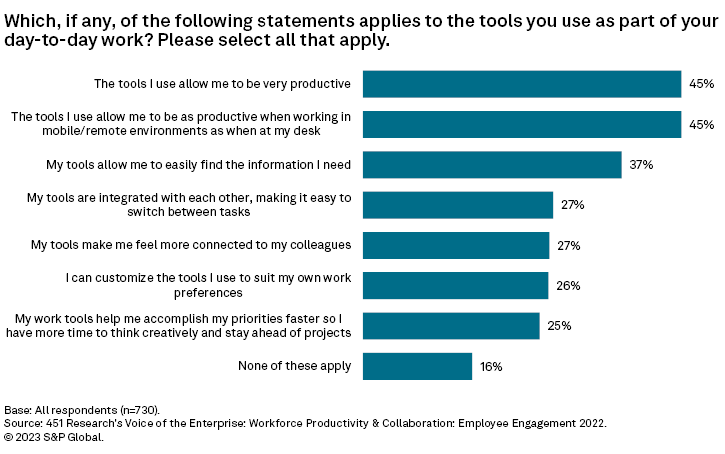S&P Global Offerings
Featured Topics
Featured Products
Events
S&P Global Offerings
Featured Topics
Featured Products
Events
S&P Global Offerings
Featured Topics
Featured Products
Events
Banking & Capital Markets
Economy & Finance
Energy Transition & Sustainability
Technology & Innovation
Podcasts & Newsletters
Banking & Capital Markets
Economy & Finance
Energy Transition & Sustainability
Technology & Innovation
Podcasts & Newsletters
S&P Global Offerings
Featured Topics
Featured Products
Events
Research — 23 Feb, 2023
According to analysis by 451 Research, part of S&P Global Market Intelligence, workplace technology is falling short in several ways, and organizations need to address these weak points to support the productivity and engagement of their employees. Organizations should take seriously how they reexamine their tech strategies as access to better day-to-day technologies ranks as one of the top 10 reasons employees would be willing to leave their current jobs. To better understand these specific workplace tech challenges, 451 Research surfaced data from its Voice of the Enterprise: Workforce Productivity & Collaboration: Employee Engagement 2022 survey to highlight three main problem areas and cover what organizations and workplace technology vendors can do to address them.

Our survey data indicates that three of the main problem areas for employees regarding their workplace technology are connection to colleagues, the ability to customize tools, and having enough time to get their tasks done faster. For organizations, these challenges represent hurdles that are impeding productivity, weakening the potential for valuable collaborative work and negatively impacting overall employee engagement. To address these challenges, organizations and the workplace technology providers they rely on should examine how their existing systems and products could be contributing to these issues and where new processes or tools can be adopted, or developed, to enhance them.

Top workplace technology challenges and their implications
Connection to colleagues, customization and time are the three weakest overall areas for surveyed employees regarding their day-to-day work tools. Only 27% of respondents said their work tools enable them to feel connected to colleagues, 26% said they have customizable tools, and 25% said their tools enable them to accomplish priorities faster. Yet, our data indicates the impact of technology influencing employee engagement and turnover. Whether employees are engaged at work seems to directly relate to whether they have positive sentiments regarding their work tools.
Our data also shows that technology plays a major role in employees wanting to stay at their current jobs, with 24% of surveyed employees saying they are willing to leave their job for better tools. Organizations should view the challenges around connection, customization and time as not only tech issues to address but as potential drivers of positive and negative employee engagement and attrition.

The issue of work tools falling short regarding time requirements came up again when we asked which changes would help employees collaborate with their colleagues better: The top response is having more dedicated time to spend on effective collaboration. The issue of employees not having enough time at work to collaborate in ways they need to also comes up in our Work Execution Goals & Challenges survey. In that survey, which asked respondents what they struggle with most when collaborating with others, the top response is not having enough time to do it. For organizations, the challenges around time and technology should be seen not only as a barrier preventing speedier task completion but as hindering potential valuable collaborative work.
How organizations can address these issues
Organizations need to examine how their various processes and systems could be contributing to the three main tech challenges of connection, customization and time. When it comes to connection to colleagues, management should model more effective modes of collaboration and general productivity so employees will adopt these modes as best practice. Helping employees free up more time to effectively collaborate with their colleagues is beneficial to organizational outcomes and employee engagement and can also help address the ongoing weakened sense of connection to colleagues since the COVID-19 outbreak. Tool customization for some organizations is an issue of security protocols and restrictions. An IT department that is given the resources and autonomy to research, troubleshoot or build out its own compliant tooling may be able to address some of the challenges around customization, at least from the internal side.
When it comes to the issue of time, complex, tedious and stringent legacy security protocols, a lack of automation in workflows, or issues of transparency and communication causing work duplication or miscommunications can all consume valuable time that employees would otherwise use for effective collaboration with their colleagues. These issues only become exacerbated when work is scattered within information silos. An organization's IT department must continuously identify silos and workflow bottlenecks that impede collaboration and overall performance. Investing in performance management technologies could help free up time by enabling administrators and employees to identify, manage and correct processes that are costing employees unnecessary time and effort, such as unproductive meetings, duplicated tasks or low-level tasks that can be automated.
Where workplace tech vendors can improve
Adopting the right tooling can play a major role for organizations' overall employee engagement. According to our Employee Engagement survey, employees who work for new tech adoption leaders have more positive sentiments regarding the effectiveness of their work tools. Workplace technology vendors should look to develop products to help address the challenges around connection, customization and time. Vendors already addressing these pain points may want to focus on further investing in these key challenge areas and ensure that their go-to-market strategy and language clearly communicate the specific ways their offerings support connection, customization and time.
Companies can adopt more visual and intuitive user experiences that support collaboration inclusivity, ideation, focus and enjoyment, all of which can contribute to a sense of connection to colleagues. This may also involve providing ways that teams can glean insight into colleagues' goals, tasks and projects, surfacing context around possible areas of overlap and collaboration.
Democratizing software is key to the issue of customization. Vendors should aim to enable teams to build custom no-code applications that sit on top of shared data, removing silos and keeping teams aligned. Additionally, tooling should aim to reduce context and app switching, which can contribute to time waste and cause employees to become distracted, confused and frustrated. By simplifying or automating repetitive tasks and embedding easy access to all of the tools an employee may need along with features such as search bars, task status updates and content tagging, workplace software providers can enable employees to focus on higher-priority tasks.
This article was published by S&P Global Market Intelligence and not by S&P Global Ratings, which is a separately managed division of S&P Global.
451 Research is part of S&P Global Market Intelligence.

